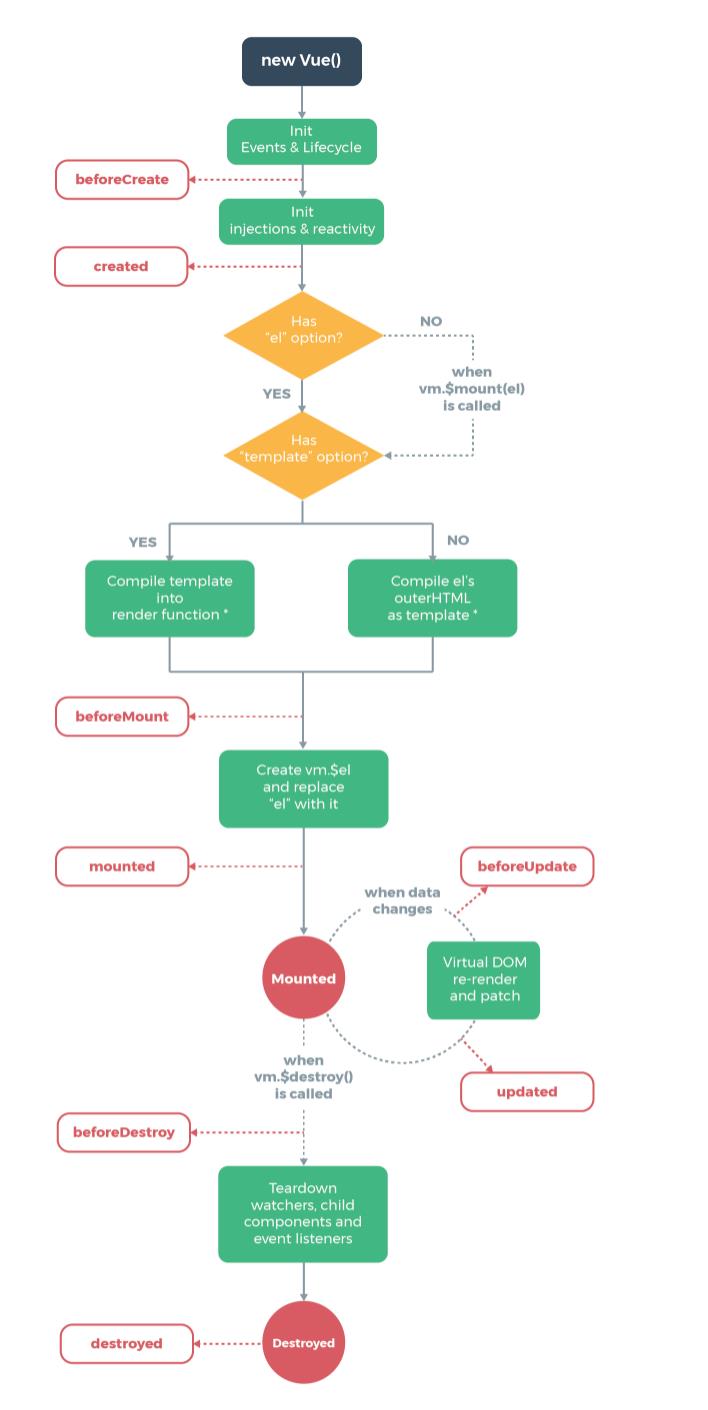vuejs生命周期函数
Posted Zina
tags:
篇首语:本文由小常识网(cha138.com)小编为大家整理,主要介绍了vuejs生命周期函数相关的知识,希望对你有一定的参考价值。

生命周期函数就是vue实例在某一个时间点会自动执行的函数
当我们创建一个实例的时候,也就是我们调用 new Vue() 这句话的时候,vue会帮助我们去创建一个实例,创建过程其实并不像我们想的那么简单,他要经过很多的步骤
Init(Events & Lifecycle):首先他会去初始化事件和生命周期相关的内容,当最基础的初始化完成的时候,在这个时间点上,vue会自动的帮我去之行一个函数,这个函数就是beforeCreate
beforeCreate:既然beforeCreate被自动之行,那么beforeCreate就是一个生命周期函数
var vm = new Vue({ el:\'#app\', beforeCreate:function(){ console.log(\'before create\') } })
我们发现这个在控制台被自动输出了,就是vue自动执行了beforeCreate这个函数,处理完这个函数,vue会继续调用一个写外部的注入,包括双向绑定的相关内容
Init(injections & reactivity): 外部的注射,各种绑定的初始化,这部分初始化完成的时候,基本上vue实例的初始化操作都完成了,在这个结点上,又会有一个自动的函数被执行,这个函数的名字叫created
created:这也是一个生命周期函数,因为他完全符合生命周期函数的定义
var vm = new Vue({ el:\'#app\', beforeCreate:function(){ console.log(\'before create\') }, created:function(){ console.log(\'created\') } })
可以看到beforeCreate执行之后,created也被自动的执行了,继续看这张图
Has \'el\' options:是否有el这个选项
Has \'template\' optioins: 是否有template这个属性
no->Compile el\'s outerhtml as template: 如果实例里面没有tempalte这个属性,会把外部el挂载点的html当作模板
yes->Compile template into render functoin: 如果实例里面有tempalte,这个时候就会用template去渲染
但是有了模板之后并没有直接渲染到页面上,在渲染之前,又自动到去执行了一个函数,这个函数是beforeMount
beforeMount:这个函数也是一个生命周期函数,也就是模板即将挂载到页面到一瞬间,beforeMount会被执行
var vm = new Vue({ el:\'#app\', template:\'<h1>hello</h1>\', beforeCreate:function(){ console.log(\'before create\') }, created:function(){ console.log(\'created\') }, beforeMount:function(){ console.log(\'before mount\') } })
可以看到beforeMount被执行了,在beforeMount执行完成后
Create vm.$el and replace \'el\' width it: 模板结合数据会被挂载到页面上,当dom挂载到页面之上,这个时候又有一个生命周期函数被执行了
mounted:在beforeMount dom并没有渲染到页面上,在mounted dom已经被渲染到页面上了,这个时候可以做个实验
<div id=\'app\'> hello world </div> <script> var vm = new Vue({ el:\'#app\', template:\'<h1>hello</h1>\', beforeCreate:function(){ console.log(\'before create\') }, created:function(){ console.log(\'created\') }, beforeMount:function(){ console.log(this.$el); console.log(\'before mount\') }, mounted:function(){ console.log(this.$el); console.log(\'mounted\') } }) </script>
看到在beforeMount输出当dom是<div id=\'app\'>hello world</div>,,在mounted输出的dom是<h1>hello</h1>这也印证了上面这张图的内容,在beforeMount的时候页面还没有被渲染,在mounted的时候页面已经被渲染完毕了
beforeDestroy,destroyed:
var vm = new Vue({ el:\'#app\', template:\'<h1>hello</h1>\', beforeCreate:function(){ console.log(\'before create\') }, created:function(){ console.log(\'created\') }, beforeMount:function(){ console.log(this.$el); console.log(\'before mount\') }, mounted:function(){ console.log(this.$el); console.log(\'mounted\') }, beforeDestroy:function(){ console.log(\'beforeDestroy\') }, destroyed:function(){ console.log(\'destroyed\') } })
刷新页面完毕,这个时候会发现beforeDestroy,destroyed并没有被触发,那什么时候被触发呢
when vm.$destroy() is called:当destroy()这个方法被调用的时候会调用beforeDestroy,当全部销毁的时候,destroyed会被执行,那怎么让他执行呢,在控制台执行vm.$destroy()的时候会调用这两个函数,还没被销毁之前会调用beforeDestroy,已经被销毁后会调用destroyed这个函数
这张图上还有两个生命周期函数,叫做beforeUpdate和updated,这两个生命周期函数在什么时候执行呢
beforeUpdate,updated:
var vm = new Vue({ el:\'#app\', template:\'<h1>hello</h1>\', beforeCreate:function(){ console.log(\'before create\') }, created:function(){ console.log(\'created\') }, beforeMount:function(){ console.log(this.$el); console.log(\'before mount\') }, mounted:function(){ console.log(this.$el); console.log(\'mounted\') }, beforeDestroy:function(){ console.log(\'beforeDestroy\') }, destroyed:function(){ console.log(\'destroyed\') }, beforeUpdate:function(){ console.log(\'before updated\') }, updated:function(){ console.log(\'updated\') } })
刷新页面看,发现这两个钩子函数其实并没有被执行,那为什么没有被执行呢,看图解释说是,when data changes,当数据发生改变的时候才会被执行
beforeUpdate:数据发生改变,还没有被渲染之前,beforeUpdate会被执行
updated:当数据重新渲染之后,updated这个生命周期函数会被执行
教程里面只有8个生命周期函数,实际上有11个生命周期函数
以上是关于vuejs生命周期函数的主要内容,如果未能解决你的问题,请参考以下文章